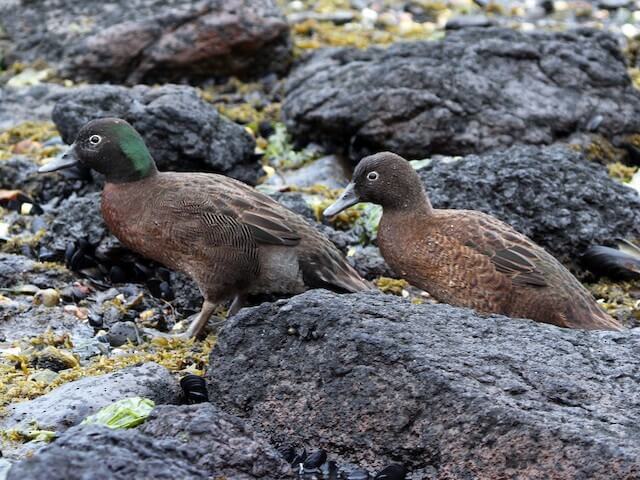Campbell Teal

Scientific Name
Anas nesiotis
Alternative Names
Campbell Island teal
Measurements
| Feature | Measurement |
|---|---|
| Length | 40–43 cm |
| Weight | 400–500 g |
| Wingspan | Greatly reduced (flightless) |
Status
The Campbell teal is currently classified as Vulnerable by the IUCN. It was previously considered extinct on Campbell Island before being rediscovered on Dent Island in 1975. After successful reintroduction efforts, its conservation status has improved from Critically Endangered to Endangered and later to Vulnerable in 2020.
Identification
A small, flightless dabbling duck with dark sepia-brown plumage. Males have a green iridescence on the head and back with a chestnut breast. Females are uniformly dark brown. Both sexes have short wings that prevent flight, dark eyes, and a subdued overall appearance similar to the Auckland teal but slightly darker and smaller.
Voice
The male produces soft piping or trilling calls, especially when alarmed or defending territory. Females give a rasping quack or growl. Vocalisations are generally quiet and heard mainly at night due to its nocturnal habits.
Diet
This species is primarily carnivorous, feeding on amphipods, insects and other small invertebrates found along shorelines, wet tussock areas and within petrel burrow systems. It forages mostly at night.
Distribution
Endemic to the Campbell Island group south of New Zealand. Historically present on Campbell Island / Motu Ihupuku, but extirpated due to Norway rats. Survived only on tiny Dent Island until conservation translocations expanded its range to Codfish Island / Whenua Hou and later back to Campbell Island.
Habitat
Found in dense tussock grasslands dominated by Poa species, as well as fern and megaherb communities. It also uses burrows and pathways created by petrels. Prefers coastal and damp terrestrial environments with vegetative cover for shelter.
Breeding
Campbell teal are territorial and monogamous. They nest in dense tussock, ferns or within sheltered pathways. Clutch size and incubation periods are similar to related species, with only the female incubating. Ducklings are precocial and remain within vegetated cover.
Wintering
This species is sedentary and does not migrate. Individuals remain within established territories year-round.
Conservation
Once presumed extinct due to predation by introduced rats, the species was rediscovered in 1975 on Dent Island. A captive breeding programme began in 1984. Releases to Codfish Island occurred in 1999–2000. Following a massive rat eradication on Campbell Island in 2001, 50 teal were reintroduced in 2004. By 2011 they were thriving, successfully restoring the species to its native range. Ongoing conservation includes monitoring and predator-free habitat maintenance.
